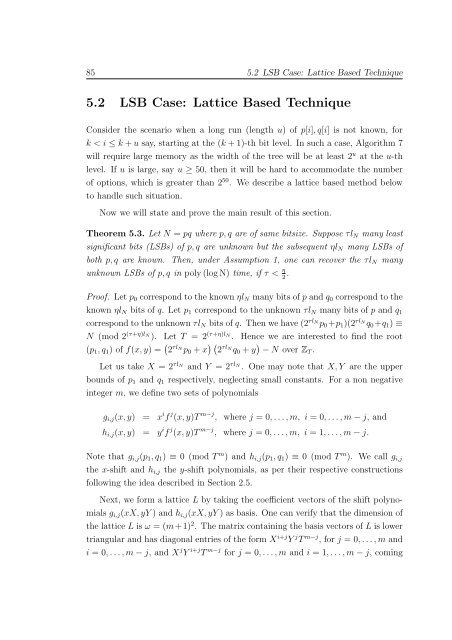Cryptanalysis of RSA Factorization - Library(ISI Kolkata) - Indian ...
Cryptanalysis of RSA Factorization - Library(ISI Kolkata) - Indian ...
Cryptanalysis of RSA Factorization - Library(ISI Kolkata) - Indian ...
You also want an ePaper? Increase the reach of your titles
YUMPU automatically turns print PDFs into web optimized ePapers that Google loves.
85 5.2 LSB Case: Lattice Based Technique<br />
5.2 LSB Case: Lattice Based Technique<br />
Consider the scenario when a long run (length u) <strong>of</strong> p[i],q[i] is not known, for<br />
k < i ≤ k+u say, starting at the (k+1)-th bit level. In such a case, Algorithm 7<br />
will require large memory as the width <strong>of</strong> the tree will be at least 2 u at the u-th<br />
level. If u is large, say u ≥ 50, then it will be hard to accommodate the number<br />
<strong>of</strong> options, which is greater than 2 50 . We describe a lattice based method below<br />
to handle such situation.<br />
Now we will state and prove the main result <strong>of</strong> this section.<br />
Theorem 5.3. Let N = pq where p,q are <strong>of</strong> same bitsize. Suppose τl N many least<br />
significant bits (LSBs) <strong>of</strong> p,q are unknown but the subsequent ηl N many LSBs <strong>of</strong><br />
both p,q are known. Then, under Assumption 1, one can recover the τl N many<br />
unknown LSBs <strong>of</strong> p,q in poly(logN) time, if τ < η . 2<br />
Pro<strong>of</strong>. Let p 0 correspond to the known ηl N many bits <strong>of</strong> p and q 0 correspond to the<br />
known ηl N bits <strong>of</strong> q. Let p 1 correspond to the unknown τl N many bits <strong>of</strong> p and q 1<br />
correspond to the unknown τl N bits <strong>of</strong> q. Then we have (2 τl N<br />
p 0 +p 1 )(2 τl N<br />
q 0 +q 1 ) ≡<br />
N (mod 2 (τ+η)l N<br />
). Let T = 2 (τ+η)l N<br />
. Hence we are interested to find the root<br />
(p 1 ,q 1 ) <strong>of</strong> f(x,y) = ( 2 τl N<br />
p 0 +x )( 2 τl N<br />
q 0 +y ) −N over Z T .<br />
Let us take X = 2 τl N<br />
and Y = 2 τl N<br />
. One may note that X,Y are the upper<br />
bounds <strong>of</strong> p 1 and q 1 respectively, neglecting small constants. For a non negative<br />
integer m, we define two sets <strong>of</strong> polynomials<br />
g i,j (x,y) = x i f j (x,y)T m−j , where j = 0,...,m, i = 0,...,m−j, and<br />
h i,j (x,y) = y i f j (x,y)T m−j , where j = 0,...,m, i = 1,...,m−j.<br />
Note that g i,j (p 1 ,q 1 ) ≡ 0 (mod T m ) and h i,j (p 1 ,q 1 ) ≡ 0 (mod T m ). We call g i,j<br />
the x-shift and h i,j the y-shift polynomials, as per their respective constructions<br />
following the idea described in Section 2.5.<br />
Next, we form a lattice L by taking the coefficient vectors <strong>of</strong> the shift polynomials<br />
g i,j (xX,yY) and h i,j (xX,yY) as basis. One can verify that the dimension <strong>of</strong><br />
the lattice L is ω = (m+1) 2 . The matrix containing the basis vectors <strong>of</strong> L is lower<br />
triangular and has diagonal entries <strong>of</strong> the form X i+j Y j T m−j , for j = 0,...,m and<br />
i = 0,...,m−j, and X j Y i+j T m−j for j = 0,...,m and i = 1,...,m−j, coming
















